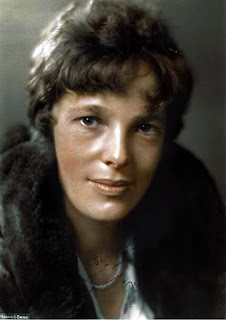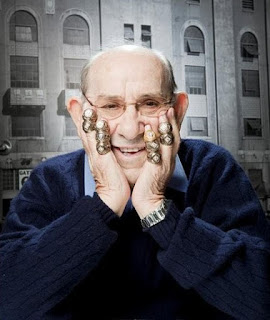.
Before I write the news, and it has been a slow couple of days, did you hear...
I recently exposed, I mean mentioned, my dreadful Putnam family secret regarding the curse of the Salem Witches. It was one of those "on you and all future generations of the Putnam family".
Well one earlier manifestation of the curse may have taken place about 85 years ago when Amelia Earhart, perhaps the greatest female aviator of all time, married one George Palmer Putnam of the New England Putnam family (the same one as the Salem Putnam family).
GP asked her to marry him six times before she finally relented, and they tied the knot February 7, 1931. Six years later, July 2, 1937, she was declared missing trying to fly around the world. So 79 years ago another Putnam succumbed to the Salem
 |
| Amelia and George Palmer Putnam |
For those of you who haven't a clue who Amelia Earhart might be, the following is from her official website and gives a neat, and short biography. This website has to be the most accurate since it is hers.
Aviator Amelia Earhart was born on July 24, 1897, in Atchison , Kansas
Yet another example of the magic of the Internet. Amelia died 78 years ago and has an official website today. That would be so much like her. Her hunger to shatter barriers and records in planes matched her desire to shatter social and cultural barriers in life.
Now I must admit, when I think about her life and death it is really strange to think she was 40 years old and trying to break the record flying around the world.
It was probably because she spent much of her youth growing up in Iowa
One last tidbit. Back in 1937 it took about 25-30 days to fly around the world. When Amelia checked in last time on her trip she had flown over 22,000 miles and had about 7,000 miles left to fly, meaning the entire odyssey would have been just about 30,000 miles.
That is one tough lady.
From her official website: http://www.ameliaearhart.com/about/bio.html


From then on, Earhart's life revolved around flying. She placed third at the Cleveland Women's Air Derby, later nicknamed the "Powder Puff Derby" by Will Rogers. As fate would have it, her life also began to include George Putnam. The two developed a friendship during preparation for the Atlantic crossing and were married February 7, 1931. Intent on retaining her independence, she referred to the marriage as a "partnership" with "dual control."
Together they worked on secret plans for Earhart to become the first woman and the second person to solo the Atlantic . On May 20, 1932, five years to the day after Lindbergh, she took off from Harbor Grace, Newfoundland , to Paris Londonderry , Ireland United States
In the years that followed, Earhart continued to break records. She set an altitude record for autogyros of 18,415 feet that stood for years. On January 11, 1935, she became the first person to fly solo across the Pacific from Honolulu to Oakland , California Mexico City to Newark
In 1937, as Earhart neared her 40th birthday, she was ready for a monumental, and final, challenge. She wanted to be the first woman to fly around the world. Despite a botched attempt in March that severely damaged her plane, a determined Earhart had the twin engine Lockheed Electra rebuilt. "I have a feeling that there is just about one more good flight left in my system, and I hope this trip is it," she said. On June 1st, Earhart and her navigator Fred Noonan departed from Miami Lae , New Guinea Howland Island Howland Island Howland Island U.S.
At 10am local time, zero Greenwich time on July 2, the pair took off. Despite favorable weather reports, they flew into overcast skies and intermittent rain showers. This made Noonan's premier method of tracking, celestial navigation, difficult. As dawn neared, Earhart called the ITASCA , reporting "cloudy, weather cloudy." In later transmissions earhart asked the ITASCA to take bearings on her. The ITASCA sent her a steady stream of transmissions but she could not hear them. Her radio transmissions, irregular through most of the flight, were faint or interrupted with static. At 7:42 A.M. the Itasca picked up the message, "We must be on you, but we cannot see you. Fuel is running low. Been unable to reach you by radio. We are flying at 1,000 feet." The ship tried to reply, but the plane seemed not to hear. At 8:45 Earhart reported, "We are running north and south." Nothing further was heard from Earhart.
A rescue attempt commenced immediately and became the most extensive air and sea search in naval history thus far. On July 19, after spending $4 million and scouring 250,000 square miles of ocean, the United States Howland I sland United States
Her birthplace,Atchison , Kansas
Her birthplace,
Today, though many theories exist, there is no proof of her fate. There is no doubt, however, that the world will always remember Amelia Earhart for her courage, vision, and groundbreaking achievements, both in aviation and for women. In a letter to her husband, written in case a dangerous flight proved to be her last, this brave spirit was evident. "Please know I am quite aware of the hazards," she said. "I want to do it because I want to do it. Women must try to do things as men have tried. When they fail, their failure must be but a challenge to others."
.
















































